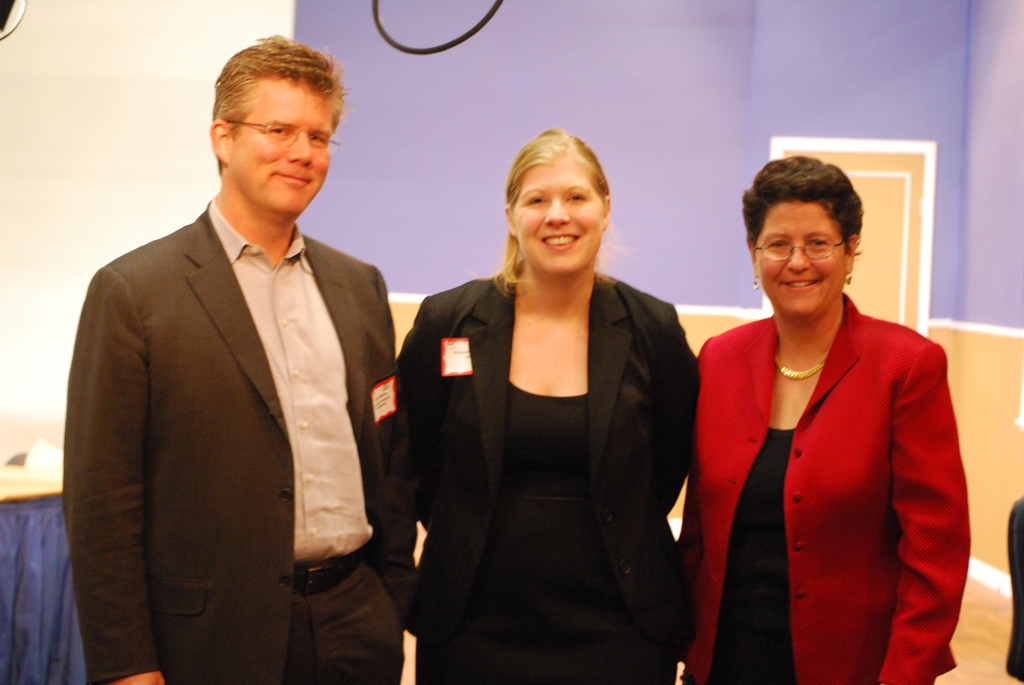By Theresa Cooper, Staff Writer
Hofstra University's Chapters of Ed2010 and the Public Relations Student Society of America (PRSSA) co-sponsored "Turning the Page: The Future of Magazines" on Wednesday, Nov. 10, 2010 during common hour in Studio A of Dempster Hall.
Moderated by Evan Cornog, the new Dean of the School of Communication, the event featured three prominent speakers from the magazine industry: Eve Burton, Vice President & General Counsel for Hearst Corporation; Stephanie Jackson, Director of Strategic Marketing Solutions for Zinio; and Philip Whitney, Vice President of Online Marketing & Product Development for American Express Publishing.
Evan Cornog began the discussion by asking the three speakers, "How have magazines changed over the past 10 years and how will they change in the next 10 years?"
"I think we've seen a shift in the way content is developed and the way that it's displayed," Stephanie Jackson began, "I should mention shorter form is definitely becoming more prevalent. From my perspective as a person from Zinio and developing digital programs, I think we've also seen more multi-channel focus. So creating content that can deliver to multiple places. So to print magazines, the website, on applications—that's been the focus that we've seen editors focus on."
For 10 years, Zinio worked with 90 percent of all magazine companies by taking their content and distributing it digitally. This means that consumers can read their favorite magazine from computers, iphones, ipads, android tablets, that will be available soon, or smart phones. Zinio also developed their own applications for these devices.
These devices that keep us connected to the world at all times also give us the ability to read articles to find out more information or go on our smart phones and read additional content or see additional photos. Print magazines have a beginning and an end, whereas magazine websites can be updated all day long with new information.
"All of these are an expansion of the editorial process," said Jackson. "So while the actual length of articles and the length of publications may be shrinking, actual content is increasing because of much broader classification of magazine content we have today."
Whitney explained that the major changes magazines have seen in the last 10 years has been the "nichification" of concepts and editorial direction of consumers.
"Niches were created and ultimately destroyed by the Internet," said Whitney. "Magazines have become increasingly focused on much smaller themes and topics. Nowadays, different applications allow consumers access to exactly what, when they want it."
Burton said, "If we were doing this panel five years ago, we would be discussing revenues and the excitement of the web."
The changes she has seen in magazines has been made in content. The Internet allows those who work for magazines to see exactly what people are looking at and what they are most interested in. "That allowed us to begin the transformation that we all needed to make as an industry to serve you what you wanted to read," Burton said.
Cornog asked, "Do these technological changes mean the potential vanishing of the newsstand?"
"The digital aspect of [magazines] changes a lot of things…what we see now, even with the digital components added on, is that here in the U.S., 80 percent of consumers are still looking to purchase subscriptions," Jackson said.
Although technological changes have thrust magazines into an even faster passed, competitive world, people are still comfortable with the tradition of ordering magazine subscriptions the old fashioned way.
Whitney explained, "On the newsstands side…the publishers are just selling fewer copies at the newsstands. And the numbers are pretty shocking in terms of how the single copy has fallen over the years."
"I think that magazines aren't going anywhere," said Dara Adeeyo, a senior majoring in Journalism and President for Hofstra's chapter of Ed2010. "Print and the web can and will coexist. The digital world is just introducing a new way for magazines to distribute their work."
Adeeyo has interned at Seventeen Magazine and HouseBeautiful. She is currently interning at TeenVogue and Alloy Digital and will be interning with Harper's Bazaar next semester.
"I think there may be more digital jobs available at magazines. The majority of my internships have been web related, so I am very comfortable with the web and knowing that the magazine industry is going to embrace the digital world makes me confident that I will be able to find a job in any realm of the industry," Adeeya explained.
Jackson and Whitney both revealed there are, currently, multiple magazine business models in transition.
Zinio, now the biggest newsstand in the world, is exploring new models that will meet with consumer needs. In one model they are considering, the consumers get to choose five magazines each month. One magazine counts as one credit and the more expensive magazines, like The Economist, which has the full price of $126.99 a year, is two or three credits.
A shift in content, consumer groups, and transforming the industry to serve the reader are all changes the magazine industry has seen in the past 10 years. We know that magazine companies have adapted to our needs. In the future, the consumer may also be adapting their ways of purchasing magazines.

(Courtney Walsh/The Chronicle)


